20th March is celebrated as the International Day of Happiness. As is the practice each year, the World Happiness Report 2023 edition was released on this day last week by the Sustainable Development Solutions Network, in collaboration with Gallup and other independent bodies. The report ranked India at a measly 126 (out of 137 nations) on the Happiness Index (Based on a three-year average score between 2020 and 2022)!
India’s Global Happiness Rank : 126
The report pegs India at global rank 126 (out of 137 nations) on the Happiness Index!
(Based on a three-year average 2020-22)
Not surprisingly, the news was all over the headlines! There were expressions of concern, of dismay, and equally expressions of disagreement and discord.
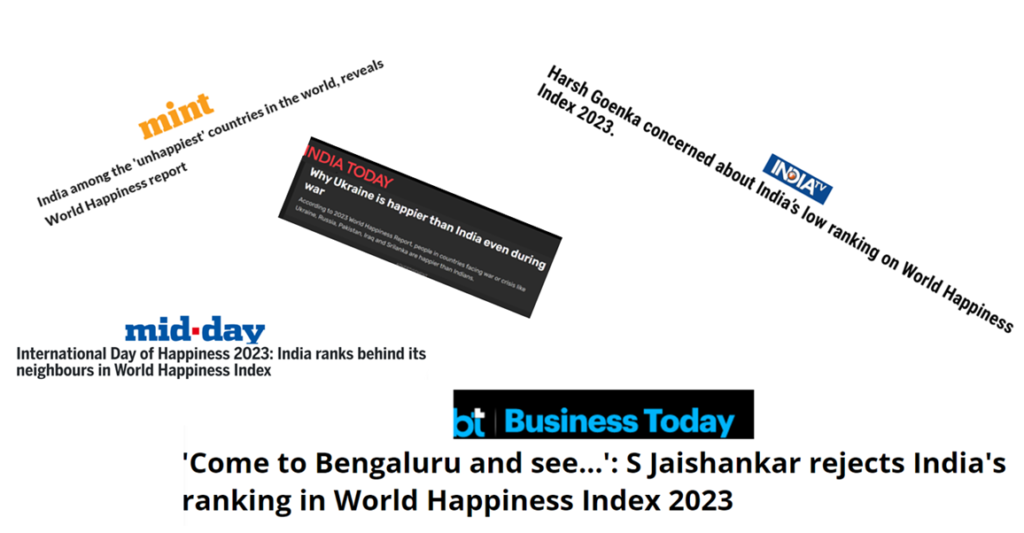
Lies, Damned Lies and Statistics?
This ranking has clearly rankled the sensibilities of many. There are questions raised on whether the data research process is scientific at all, or as Mark Twain once famously proclaimed, is it a case of “Lies, Damned Lies and Statistics?” Does the underlying data actually present a picture of concern, or is it just malicious propaganda directed at India at a time when it holds the presidency of the G20? Let us analyze!
The report captures data for 137 nations across the globe. To simplify the visuals from the perspective of this analysis, we will focus on 23 of those 137 nations. The reference set of 23 are chosen as follows:
| Reference Nations | Why these nations have been chosen in the reference set |
| G20 Group of Nations | India is a constituent of G20, and holds the G20 presidency currently. |
| Finland and Denmark | Respectively ranked 1 and 2 on Happiness Index in the 2023 report |
| Pakistan and Sri Lanka | India’s neighbors. Both rank higher than India in the 2023 report. And yet, both are going through the throes of severe economic crisis, and wouldn’t really be described by their own people as happy places currently. |
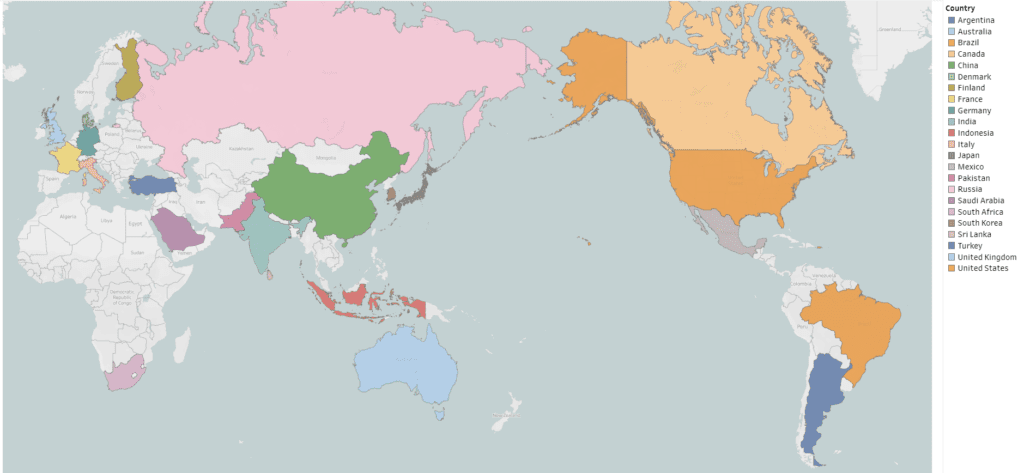
Data Driven Analysis
Rather than debating at a subjective and emotive level, let us delve deep into the data, and try to answer these questions:
1. Does the report follow a scientific process to draw its conclusions?
2. What parameters have been used to measure happiness and how is data collected?
3. How does India perform on each of the parameters?
4. Is the sample size and data collection approach sufficient to draw the conclusions provided in the report?
5. What part of the report should India focus on, and what part can be taken with the proverbial grain of salt?
To start with, the authors of the report seem to have followed the typical standards expected out of a research report – variables are well defined, data collected is provided for public reference, limitations and conclusions are explained in detail, and at least at a bird’s eye view level, a scientific process seems to have been followed. However, the devil often lies in the detail. In computing the Happiness Index (Life Ladder), the report banks upon six primary variables and two auxiliary variables, as shown in the table below:
| Variable | How it is measured | India’s Global Rank based on 2020-2022 average | Remarks |
| Log GDP per capita | Log of GDP per capita in PPP (purchasing power parity) terms as reported from World Development Indicators report (last updated Jan 2023) | 96 | |
| Social Support | Binary (0 or 1) response to the survey question – “If you were in trouble, do you have relatives or friends you can count on to help you whenever you need them, or not?” | 121 | |
| Healthy Life expectancy at birth | Life expectancy data published by World Health Organization’s Global Health Observatory | 98 | |
| Freedom to make life choices | Response to the survey question – “Are you satisfied or dissatisfied with your freedom to choose what you do with your life” | 20 | |
| Generosity | Response to the survey question – “Have you donated money to a charity in the past month?”, regressed on GDP per capita. | 59 | |
| Perception of Corruption | Response to the survey questions – “Is corruption widespread throughout government or not” and “Is corruption widespread within businesses or not?” | 69 | Reverse Rank |
| Positive Affect | Response to the survey questions on recent experience of smile/laughter, enjoyment and learning or doing something interesting. | 103 | |
| Negative Affect | Response to the survey questions on recent experience of sadness, worry and anger. | 20 | Reverse Rank |
Facts about the Report
1. The average sample size per nation for the questions that involved subjective surveys is only 1000!
2. The sample size for subjective surveys in regards to India is only 3000!
3. No data was reported for Pakistan and Sri Lanka in 2022! (The report has extrapolated from previous years – 2019-2021 for these nations)
Survey Sample size for India : 3000
The survey size represents a measly 0.00021% of India’s population. Now, it may be argued that even such a small size is sufficient if the sample is representative of the population. However, given the diversity in India’s population, such an argument would fall flat on its face!
Lets now analyse India’s score against the reference group of nations based on each variable.
GDP per capita
India’s GDP per capita (measured in the report as ‘log GDP per capita’) is very low as compared to the reference group. India ranks in the lower quadrant of the reference group, and its global rank is 96.
This is a genuine observation and reflects a true problem with India’s current stage of economic growth. Even though India as a nation has grown into the fifth largest economy globally, its per capita GDP continues to be abysmally low. This, in fact, represents the biggest challenge that India has to tackle in its upcoming years of progress. GDP growth for the nation is fairly guaranteed, but the effects of the growth must percolate to the weakest sections of the population!

Social Support
As per the report, India scores fairly low in comparison to the reference group on the Social Support variable with a global rank of 121. This is a surprising observation. A ground reality analysis of India’s social fabric would negate this observation. Social and family structures in India are extremely strong, especially in times of crisis. In fact, I would even argue, that it is amongst the population that is at the lower end of per capita income that social support tends to be the strongest. Clearly, the researchers need to look at this variable more carefully. Could it be that the extremely small sample size has skewed the results? The likelihood of sampling error is high!

Healthy Life expectancy
India ranks in the lower quadrant on Life expectancy compared to the reference group and has a global rank of 98. However, at a life expectancy of 61.2 years in 2022, this statistic is not alarming. Certainly, the expectation should be that average life expectancy will increase some more as the nation develops. Continuing to invest in improving health infrastructure should certainly be a priority. But beyond, this the data doesn’t reflect any cause for concern.

Freedom to make life choices
As per the report, India scores quite high on this variable, ranking within top 5 in the reference group, and ranking in top 20 globally.
Note: While this is not really the focus of this particular analysis, I was surprised by Saudi Arabia appearing in the top 5 within the refence group in 2021 (no data for Saudi Arabia in 2022). No offence meant to the people of that nation, but it is common knowledge that one gender has been completely excluded from most expressions of freedom historically. There are recent attempts at reforms to ameliorate this situation, but the reforms are only in very nascent stages. Clearly, the researchers need to review this variable for both definition and sampling errors!

Generosity
As per the report, India ranks about mid-way on this variable, both within the reference group and withing the global ranking. No significant cause for concern on this front.
However, from the point of view of validity, I have an observation. Generosity is being measured through a very western philosophical lens of “donating money to a charity”. If you ask the average person on the street in India this question, they may not relate to the idea of donating money to “charitable organizations”. At the same time, in reality they may have just the other day dropped a contribution in the temple hundi, or partaken in a gurudwara langar or donated a “chadar” at a dargah, acts that they themselves would not have categorized mentally under “donating money to charity”. Historically, the notion of charity in India has been closely tied to its religious, spiritual and social institutions and not the western concept of private “charitable” organizations.
And what about generosity that is not related to money? Money is not the all-encompassing priority in all cultures. Factoring cultural context and nuances in a research question relating to variables such as Generosity is extremely important if reliability and validity of data is sought, and if such researches are to remain globally relevant.

Perception of Corruption
As per the report, India scores poorly on this variable, and truth be told, the ground reality reflects this score. Corruption is indeed widely perceived to be rampant especially in the common citizen’s interaction with government agencies. Clearly, this is a variable on which the nation has much work to do as it develops further. Although, one must admit that development in itself does not root out corruption, especially at the highest levels of governance, as can be seen from the scores of United States.
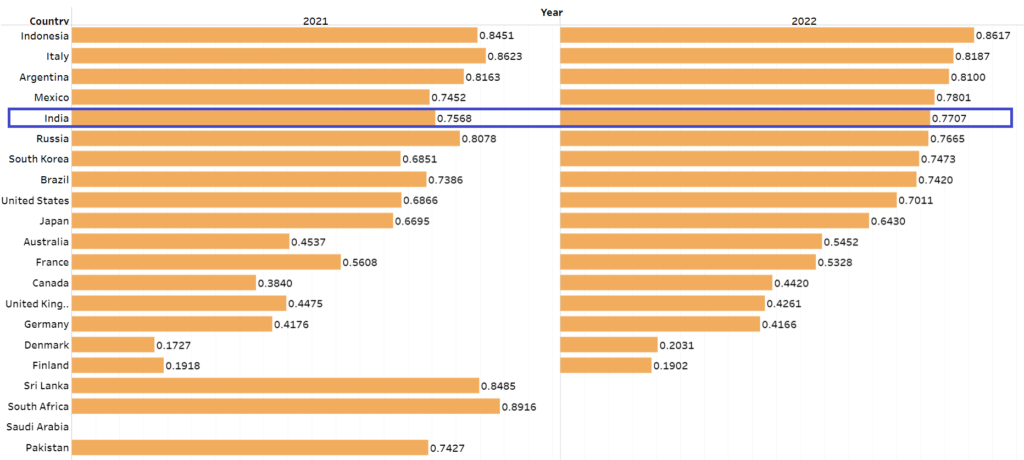
Positive and Negative Affect
As per the report, India ranks low on both these fronts, doing particularly poorly on the negative effect. Given that both these scores are related to perception questions, whether or not a sample size of merely 0.0021% reflects the true perception of the population can however be debated.
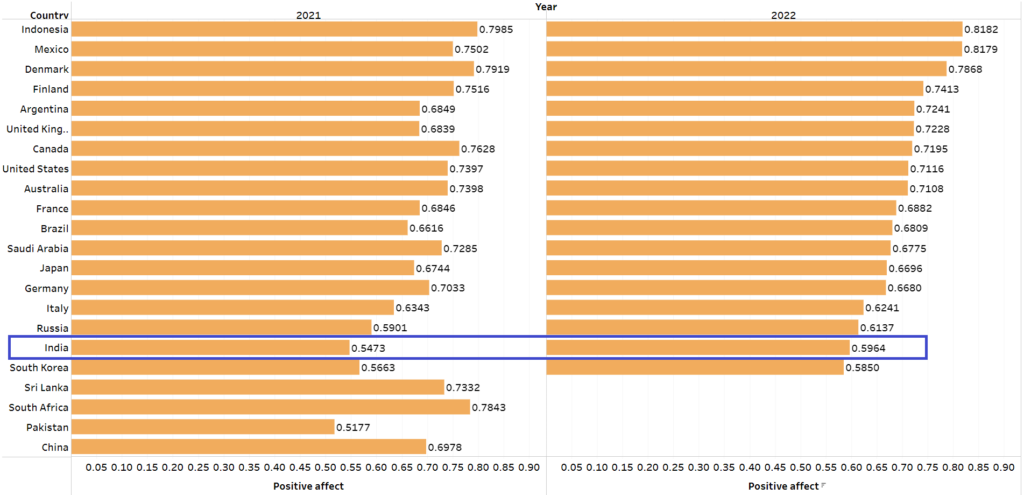
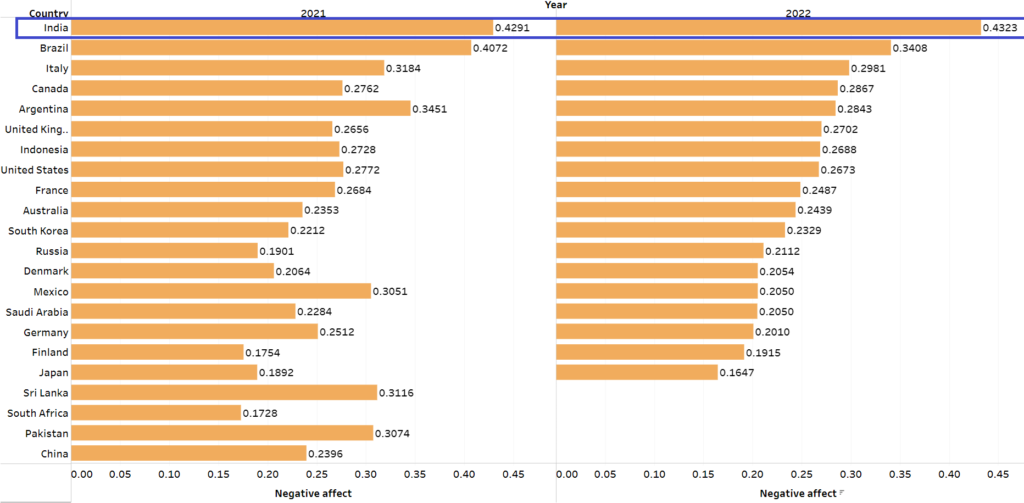
My Conclusions
As per my analysis of the report and the underlying data provided, there are two variables that India must pay attention to and represent significant areas of concern. These are – GDP per capita (making economic growth reach the person at the lowest end of the ladder), and Perception of corruption (eliminating corruption especially as experienced by the common citizen in interactions with government).
Beyond these two variables, the findings on the other variables can frankly be taken with a healthy pinch of salt. There are questions on the statistical validity of the findings due to the small sample size and cultural validity for some of the subjective research questions is debatable. Clearly, much deeper research with sufficient samples from each geographical part of the nation is required before any sweeping conclusions can be drawn.
And my last observation is not about the survey itself, but about the reading of the survey. The big headlines are what people remember, such as the statement that India ranks lower than Pakistan and Sri Lanka. The nuances in the fine print get missed, such as the fact that data has not even been reported for both these crisis-stricken nations in 2022. And to that extent, I must sign off by agreeing with Mark Twain. If you look at reports only through the lens of the headlines, and do not look at the nuances of data, it does indeed stand the risk of devolving into lies, damned lies and worse, lies reinforced by statistics!
References
World Happiness Report 2023 : https://happiness-report.s3.amazonaws.com/2023/WHR+23.pdf
Details of Variables, Sample sizes and Data Collection : https://happiness-report.s3.amazonaws.com/2023/WHR+23_Statistical_Appendix.pdf
Appendices and Data provided with the report: https://worldhappiness.report/ed/2023/#appendices-and-data
The visualizations illustrated in my analysis: https://public.tableau.com/app/profile/vinod.nair7526/viz/WHR_Analysis/WorldHappinessReport-Analysis
Parting Note
I will probably follow up with an article analyzing the variables and the regression model of happiness suggested by the report further, and try to answer the question – do these variables really predict happiness?. Do leave comments if you would like anything specifically analyzed, or indeed if you have observed anything interesting in your own reading of the data.

Vinod Nair is the Founder of HumaLitix, where he specializes in Data Science and Business Analytics.
